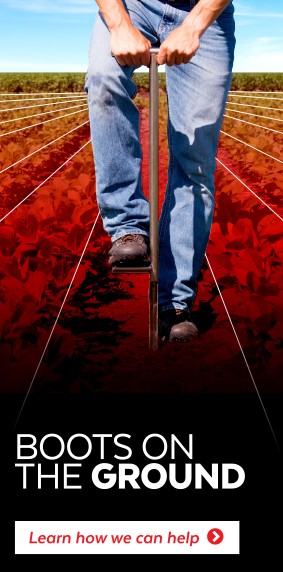Signs of Stress and Injured Crops In the Field Caused By
Environmental Factors
Crops are continually bombarded by external factors that can greatly affect the plants’ overall health and potential yields throughout the growing season. Certain environmental, chemical, mechanical, and soil nutritional factors can lead to plant stress and injury. Growers need to be able to identify the signs of plant stressors and injuries to make informed management decisions. In this article, we will cover some of the environmental factors that affect crops.
Drought
Essential for any plants, water is key for the success of crop development. Crops utilize water in various ways through transpiration, where water moves from the roots to the rest of the plant and is evaporated from pores in the leaves, stems, and flowers. This process helps the plant diffuse carbon dioxide from the air for photosynthesis, self-cooling, and accounts for the flow of nutrients and water from the roots to the rest of the plant.
As the plant grows, the water demand to keep this process going also increases. When the available amount of water in the soil dips below the plants’ transpiration needs, such as in drought conditions, it reduces the uptake of nutrients and causes stress.
Signs and Symptoms
For corn, the main sign that they are stressed due to lack of water is that their leaves will begin to roll. As drought conditions get worse, the corn leaf rolling will become more apparent. Yield loss can be a possibility when the drought conditions persist for more than four consecutive days. Depending on when the dry spells occur, the drought severity, and the corn growth stage, yield losses can vary from 0-9 bushels per day of stress.
The way soybeans act during a drought is that the plants will begin flipping over their leaves, where the underside of the leaf is turned up. Before leaf flipping, reduced vegetative growth can occur. In sustained droughts, the plant leaf trifoliate will close up, and the center leaflet will be sandwiched between the outside leaflets.
Flooding
Heavy rains and flooding can also create a big issue for crops and the soil. For crops, standing water depletes soil oxygen and can inhibit important plant functions to stay alive. Completely submerged crops are more susceptible to injury than those partially submerged, as the likelihood of mud and other material could cover the leaves and slow down photosynthesis.
Flooding causes issues with the soil too. Floodwaters will take away nitrogen in the soil and affect the plants’ health. Once standing water subsides, the soil will dry and can crust up. This crusting can impede the emergence of seedlings. A rotary hoe can be used to break up the crusting soil.
Signs and Symptoms
Depending on the amount of water and crop growth stage, flooding can cause yellowing, wilting, stunting, or plants’ death. Root systems can be damaged, leading to instances of root or stem rot. Symptoms of root and stem rot can show up as yellow- brown lesions which eventually turn dark brown.
Frost
Freezing temperatures can significantly damage crops if frost occurs before they reach maturity. In earlier developmental stages, crops like corn and soybeans are both susceptible to damage. However, soybean seedlings are more likely to be affected due to their growing points being exposed to the outside environment as soon as they emerge. The growing area of corn usually remains insulated below ground until the 5- leaf collar stage.
Lethal frost levels can happen around 28˚ F or less if experienced for more than a few hours. The type of damage it causes to your crops won’t be shown right away. Wait a few days before evaluating your fields.
Signs and Symptoms
If the frost occurs early in the growing season, some early signs of crop injury can be identified a few days after freezing. In soybeans, there’s usually soft, shrunken, discolored hypocotyl and cotyledonary tissue. Seedling survival can be gauged if the cotyledonary bud shows signs of growth after the freeze event. Emerging corn will show water-soaked and discolored tissue near the growing point. With corn in the 5-leaf collar stage, the injury will show up in water-soaked, discolored leaf tissue.
Contact A Crop Consultant
It can be challenging to determine the full extent of crop damage after an environmental event such as the ones covered in this article. Luckily there are experts out there that can help. E4 Crop Intelligence has a field scouting program to alert growers about field problems before they become unmanageable.
